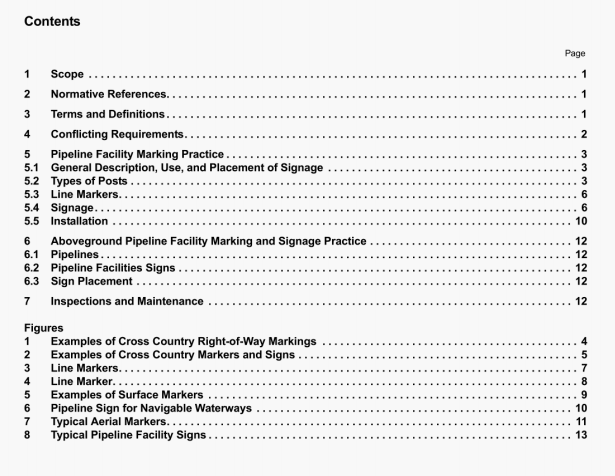API RP 1109:2010 pdf download.Marking Liquid Petroleum Pipeline Facilities.
5 Pipeline Facility Marking Practice
5.1 General Description, Use, and Placement of Signage
5.1.1 S.griage can be found in various shapes. sizes, and designs. Pemianent pipeline facility markets and signs are used to convey the following information to the pubc and emergency responders:
a) the presence of a liquid petroleum pipeline facility;
b) a potential hazard warning;
C) the contact telephone number of the pipeline operator for any of the following:
1) to determine the location of the buried pipeline,
2) to receve authonzatiori to cross or occupy the pipeline rights-of-way,
3) to report emergencies relating to the pipeline or pipeline right-of-way.
5.1.2 Pipeline personnel may use pipeline markers. aerial markers and other signs to readdy identify their pipeline, pipebne right or way, or crossing in the course of various day-to-day operation and maintenance activities or emergency response.
5.1.3 The placement of signage is dependent on the purpose, type of signage, and local conditions. When installing pipeline markers, for example, consideration should be given to installing them on each side of public roads, railroad crossings fence lines, property lines, water crossings, above ground crossings, and other locations accessible to the public. When installing Aerial Markers, consideration should be given to terrain, land use adjoining the ROW. flight path, and physical points along the ROW to be identified, such as P1’s and main line—lateral take-offs, When determining the frequency and spacing between markers, consideration should be given to land use, terrain, environment, population density, local ordinances, and other damage prevention considerations such as special excavation activity, one call law exemptions, and frequency of excavated related near misses.
Line Markers should be installed over each pipeline; however, there are locations where it is impractical, such as when a pipeline runs down the middle of the street. parallels the road under the shoulder, or traverses heavily developed urban areas. Line markers that are not placed over the pipeline should denote that the line Is offset. Supplemental signage such as curb markers, ground level markers or pavement decals should also be considered.
At a minimum, locations should be chosen to meet or exceed the requirements of 49 CFR Part 195.
Examples of cross country right-of-way line markings are shown in Figure 1 and Figure 2.
5.2 Types of Posts
The type of post used will be dependent on the signage used and location. Posts may be made of any materials that will ensure adequate strength, stiffness, visibility, and durability. To maintain structural integrity and appearaice, some post materials requwe surface protection against above- and below-ground corrosion or weathering. A proven coating system that provides a suitable finish and nonfading color should be selected for this purpose. The following criteria should be applied m the selection of marker posts.
a) Metal pipe posts should be straight, sound, and have a nominal diameter of 2 in. or larger.
API RP 1109:2010 pdf download
